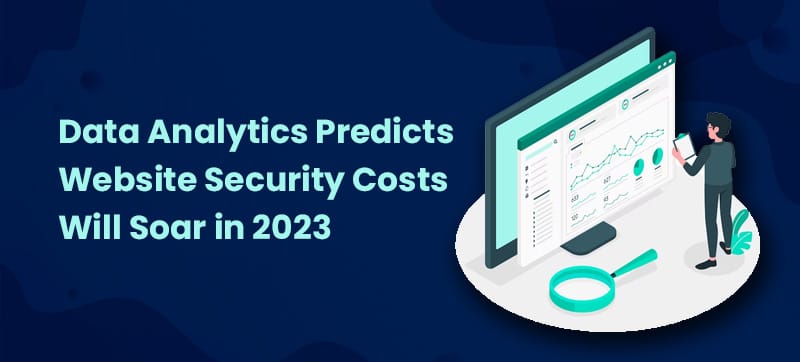A recent study found that the global cost of cybercrime will reach a staggering $2 trillion by 2023. That’s a considerable number, and it will only continue to grow as more and more businesses become reliant on digital platforms. The good news is that there are steps you can take to protect your business from cybercrime. In this blog post, we’ll discuss how data analytics can help you stay ahead of the curve regarding website security. Stay safe out there!
Overview
The world of cybersecurity is rapidly changing. By 2023, it’s anticipated that the cost of website protection and upkeep will have increased dramatically as both the quantity and sophistication of cyber threats increase. For businesses, this will mean investing more resources into data analytics tools that can identify and protect against emerging digital threats. This blog post will explore how data analytics can help predict website security costs in 2023 and provide strategies for staying ahead of the curve.
What Is Data Analytics?
Before delving into ways that data analytics can help protect websites from potential attacks, it’s essential to understand precisely “data analytics”. In a nutshell, data analytics is collecting, analyzing and interpreting data to gain insights or make predictions. It helps organizations identify trends and patterns in their data that can provide valuable information about customer preferences and behaviors.
Data analytics can be used for various purposes, including predicting website security costs. By using algorithms to analyze large amounts of web traffic data, it’s possible to anticipate which threats may target a website in the future, enabling businesses to proactively protect their websites from attacks.
How Data Analytics Can Predict Website Security Costs:
There are several ways data analytics can help predict website security costs in 2023. Some of the most effective methods include:
1. Analyzing Web Traffic
Analyzing web traffic data is one of the most effective ways to predict website security costs. Monitoring a website’s incoming and outgoing web traffic makes it possible to identify potentially malicious activities such as SQL injections, brute force attempts and cross-site scripting. This can help businesses anticipate future attacks and take steps to protect themselves from them.
2. Monitoring User Behavior
Data analytics tools can also be used to monitor user behavior on websites. Tracking how users interact with a website makes it possible to identify any suspicious activity that could indicate potential cyber-attacks or other malicious activities. This allows businesses to stay ahead of the game and proactively address security issues before they become more costly.
3. Analyzing Network Activity
Network activity is another critical factor in predicting website security costs. By analyzing the amount of data a website receives, it’s possible to identify potential threats that could target the website’s infrastructure or security systems. With this information, businesses can take preemptive measures to protect their websites and prevent costly attacks in the future.
4. Monitoring Social Media
Social media is a valuable tool for predicting website security costs. By monitoring posts and comments on social media sites, it’s possible to identify potential online threats that could target a company’s website. This allows businesses to stay ahead of the curve and proactively protect their websites from malicious activities.
5. Analyzing Third-Party Services
Website owners often use third-party services to enhance their websites’ functionality. While these services can be beneficial, they can also introduce potential security risks. Data analytics tools can help identify any potential vulnerabilities associated with third-party services and provide insights into how businesses can protect their websites from malicious activities.
How to Use Data Analytics for Cost Predictions:
Now that we know how data analytics can predict website security costs, let’s discuss some strategies for using these tools effectively. Here are some tips for making accurate cost predictions with data analytics:
1. Establish Clear Goals
The essential step in using data analytics to predict website security costs is to establish clear goals. What are you trying to achieve with your predictive model? Are you looking for insights about customer preferences or identifying potential threats? Knowing these questions answers will help you create a more accurate cost prediction.
2. Gather Relevant Data
Once you’ve established your goals, it’s time to gather relevant data that can be used in the predictive model. This includes web traffic data, user behavior data and network activity data. The more comprehensive the dataset, the more accurate the cost predictions will be.
3. Use Advanced Analytics Techniques
When analyzing data for cost predictions, it’s essential to use advanced analytics techniques such as machine learning & natural language processing. These tools can help identify patterns in large datasets that would otherwise be difficult to detect with manual analysis.
4. Validate the Results
After you’ve created your predictive model, it’s crucial to validate the results before making any decisions. Are the predictions accurate? Do they align with your goals? If not, you may need to adjust your model or gather additional data.
5. Implement the Predictions
Once you’ve validated your predictions, it’s time to implement them. Make sure to take all necessary steps to protect your website and minimize security costs in 2023. This may include investing in new technologies or updating existing systems.
Businesses can stay ahead of the game by using data analytics to predict website security costs and proactively protect their websites from potential threats. With the right strategies in place, businesses will be well-prepared for any cyber-attacks in 2023.
Conclusion
Data analytics is a powerful tool for predicting website security costs in 2023. By analyzing web traffic, user behavior and network activity, it’s possible to anticipate potential threats and take proactive steps to protect websites from malicious activities. With the right strategies in place, businesses can use data analytics to make accurate cost predictions and protect their websites from costly attacks in the future.






